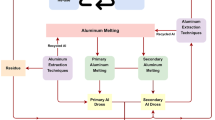Abstract
Prior to the mastering of metallic zinc production in the mid-19th century, brass making in Europe was based on the so-called cementation process: within a more or less closed vessel, gaseous zinc is produced by the carbothermic reduction of zinc ore at around 1,000°C (±100°C), and simultaneously diffuses into metallic copper. Few ancient brass objects dated before the Industrial Revolution analyzed so far bear more than 30 wt.% zinc, so that this zinc content value has become a dating criterion for these artifacts. The systematic laboratory-scale experimental simulations of the ancient process presented here permit the multiple influences of temperature, isothermal treatment duration, and initial Zn/Cu ratio on the zinc content of the final products, and on the zinc recovery rates as well, to be investigated for the first time.
Similar content being viewed by others
References
P.T. Craddock and K. Eckstein, “Production of Brass in Antiquity by Direct Reduction,” Mining and Metal Production through the Ages, ed. R Craddock and J. Lang (London: Archetype, 2003), pp. 216–230.
B.P. Jalan and Y.K. Rao, The Reduction of Zinc Oxide by Carbon“Non-Catalyzed Reaction (Montreal, ON, Canada: Metall. Soc. CIM, 1977), pp. 1–5.
J. Maréchal, “La Fabrication du Laiton Avant la Decouverte du Precédé Dony d’extraction du Zinc,” Bulletin Scientifique de l’Association des Eleves des Ecoles Speciales (AEES), 36(1) (1938), pp. 1–13.
J. Day, “Brass and Zinc in Europe from the Middle Ages until the Mid-nineteenth Century,” 2000 Years of Zinc and Brass, ed. P.T. Craddock (London: British Museum, 1998), pp. 132–158.
O. Werner, “Liber das Vorkommen von Zink und Messing im Altertum und im Mittelalter,” Erzmetall, 23(6) (1970), pp. 259–296.
G. Rolandi and G. Scaciatti, “Ottone e Zinco presso gli Antichi,” Industria Mineraria (November 1956), pp. 759–770.
K. Maedecke, “Gleichgewichtsverhältnisse bei der Messingherstellung nach dem Galmeiverfahren,” Erzmetall, 26(5) (1973), pp. 229–233.
H. Grothe, “Uber die Herstellung von Messing nach dem alten Galmeiverfahren,” Erzmetall, 24(12) (1971), pp. 587–592.
J.M. Welter and F. Revet, “Precédé de Recyclage de Dechets de Fonderies de Laitons” O.E.D. brevets FR 2-762-328 (1997).
H. Ullwer, “Messingherstellung nach dem alten Galmeiverfahren,” Erzmetall, 54(6) (2001), pp. 319–326.
B. Newbury et al., “Revisiting the Zinc Composition Limit of Cementation Brass,” Historical Metallurgy, 39 (2005), pp. 75–81.
H. Ullwer, “Das alter Galmeiverfahren und die Erreichbarren Zinkgehalte,” Erzmetall, 61(5) (2008), pp. 324–327.
M. Martinon-Torres and T. Rehren, “Agricola and Zwickau: Theory and Practice of Renaissance Brass Production in SE Germany;” Historical Metallurgy, 36 (2002), pp. 95–111.
J.-M. Welter, “The Zinc Content of Brass: A Chronological Indicator,” Techné, 18 (2003), pp. 27–36.
T. Rehren and M. Martinon-Torres, “Naturam ars Imitata: European Brassmaking between Craft and Science,” Archaeology, History and Science. Integrated Approaches to Ancient Materials, ed. M. Martinon-Torres and T. Rehren (Walnut Creek, CA: Left Coast Press, 2008), pp. 167–188.
D. Bourgarit and N. Thomas, “Texts versus Experiments: New Insights on the Brass-cementation Process,” Journal of Archaeological Science (in prep.).
P.R.S. Moorey, Materials and Manufacture in Ancient Mesopotamia: The Evidence of Archaeology and Art-Metals and Metalwork, Glazed Materials and Glass, British Archaeological Reports, International Series, ccxxxvii (Oxford: 1985).
R.F. Tylecote, A History of Metallurgy (London: Institute of Metals, 1992).
T. Calligaro et al., “Development of an External Beam Nuclear Microprobe on the AGLAE Facility of the Louvre Museum,” Nuclear Instr. and Methods in Phys. Research, Section B, 161 (2000), pp. 328–333.
O. Kubaschewski and C.B. Alcock, Metallurgical Thermochemistry, 5th ed. (Int. Series on Materials Sciences and Technology), Vol. 24 (Oxford, U.K.: Pergamon Press, 1979).
J. Benard et al., Métallurgie Générale (Paris: Masson, 1991).
E.H. Baker, “Vapour Pressure and Thermodynamic Behaviour of Liquid Zinc-copper Alloys at 1150°C,” Transactions of the Institute of Mines and Metallurgy, Sec. C (1970), pp. 1–5.
D.E. Tyler and W.T. Black, “Introduction to Copper and Copper Alloys,” Properties and Selection: Non-ferrous Alloys and Special-purpose Materials (ASM Handbook, Volume 2) (Materials Park, OM: ASM International, 1992).
J.M. Welter, personal communication (2009).
H. Chen, “Effect of Additives on Carbothermic Reduction of Zinc Oxide,” Journal of Materials Science Letters, 18 (1999), pp. 1399–1400.
M. Chen, “Kinetic Study on the Carbothermic Reduction of Zinc Oxide,” Scandinavian Journal of Metallurgy, 30 (2001), pp. 292–296.
ASM Metals Handbook, 8th edition, vol. 8 (Materials Park, OH: ASM International, 1973).
R.O. Hultgren et al., Selected Values of Thermodynamic Properties of Metals and Alloys (New York: Wiley, 1956/1963).
R. Everett et al., “The Activity of Zinc in Liquid Copper-zinc Alloys,” Acta Metallurgies, 5 (1957), pp. 281–284.
Author information
Authors and Affiliations
Corresponding author
Rights and permissions
About this article
Cite this article
Bourgarit, D., Bauchau, F. The ancient brass cementation processes revisited by extensive experimental simulation. JOM 62, 27–33 (2010). https://doi.org/10.1007/s11837-010-0045-3
Published:
Issue Date:
DOI: https://doi.org/10.1007/s11837-010-0045-3




